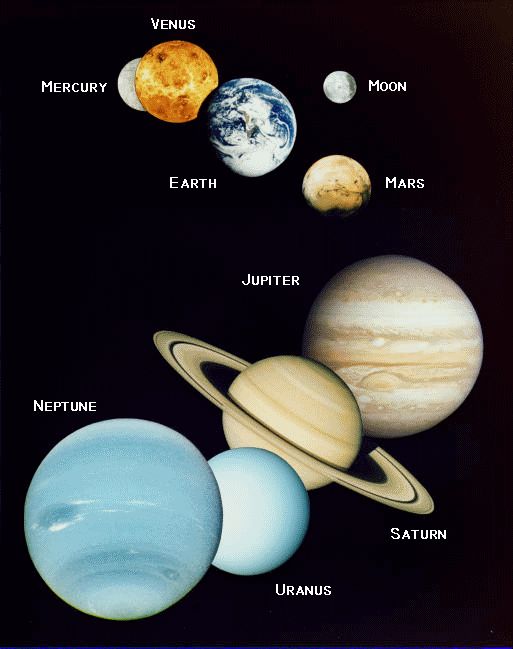There are eight planets in the Solar System namely: the Mercury, Venus, Earth, Mars, Jupiter, Saturn, Uranus, and Neptune. We supposed to have nine planets but the ninth planet, the Pluto is very small. It is smaller than seven of the solar system’s moons (the Moon, Io, Europa, Ganymede, Callisto, Titan, and Triton) so they decided to emit Pluto as a planet. This eight known planets o the solar system are grouped into two classes – the terrestrial planets and gas planets. The terrestrial planets are Mercury, Venus, Earth and Mars. They are inner planets that are small and solid planets made up of rock and metal. The gas planets are Jupiter, Saturn, Uranus and Neptune. They are outer planets, they may have solid cores but they are made up mostly of gases, which are very different from the Earth’s atmosphere.
In Roman Mythology, Mercury is the god of commerce, travel and thievery, the Roman counterpart of the Greek god Hermes, the messenger of gods. It moves so quickly across the sky and this is maybe the reason how it got its name. It is the 8th largest and the closest to the sun. It is the only body in the solar system known to have a rotational resonance or frequency with a 1:1 ratio. Mercury has no known satellites.
Venus is the goddess of love and beauty but its surface features were name for female figures. This was named this goddess probably because it is the brightest of the planets known to the ancients. It is the 2nd planet from the sun and the 6th largest. Its orbit is the most nearly circular of that of any planet, with an eccentricity of less that 1%. Venus has no satellites. It is usually visible with the unaided eye. Sometimes referred to us the “morning star” or “evening star”, it is by far the brightest star in the sky.
The goddess of the Earth was Tellus – the fertile soil. It is the 3rd from the sun and the 5th largest and the only planet with abundant liquid water and know life. The Earth is the heaviest body in the solar system. It is the only planet on which water can exist in liquid form on the surface and liquid water is of course essential for lie as we know it. Earth has only 1 natural satellite, the moon and it is called Luna.
Mars is the god of war. The planet probably got this name due to its red color. Sometimes it is referred to us the red planet. There are 2 tiny satellites in Mars namely: Phobos and Deimos. It is the 4th planet from the sun and the 7th largest.
Jupiter is the 5th planet from the sun and by far the largest. It is more than twice as massive as all the other planets combined. Jupiter was the king of the gods, ruler of Olympus and the patron of the Roman State. It is the 4th brightest object in the sky (after the sun, moon and Venus at some times Mars is also brighter). Jupiter has rings that are dark, dimmer and smaller than of Saturn. They’re probably composed of very small grains of rocky material. Jupiter has 61 known satellites: the 4 Galilean moons, 23 smaller known and named and many more small ones discovered lately but not yet named.
Uranus is the 7th planet from the sun and the 3rd largest (by diameter). It is the larger in diameter but smaller in mass than Neptune. Uranus was the 1st planet discovered in modern times by William Herschel on March 13, 1781. It is composed primarily of rock and various ices with only about 15% hydrogen and a little helium. Uranus has rings, they are very dark and they are composed of fairly large particles ranging up to 10 meters in diameter in addition to fine dust. There are 11 known rings, all very faint; the brightest is known as the Epsilon ring. Uranus is sometimes just barely visible with the unaided eye on a very clear night; it is fairly easy to spot with binoculars. Uranus has 20 named moons (plus one recently discovered which has no yet given an official name). Uranus’ moons take their names from the writings of Shakespeare and Pope unlike the other bodies which have names from classical Mythology.
Neptune is the 8th planet from the sun and the 4th largest (by diameter). It is smaller in diameter but larger in mass than Uranus. Neptune was the god of the sea it has rapid winds confined to bands of latitude and large storms or vortices. Neptune’s winds are the fastest in the solar system reaching 2000 kilometers per hour. Neptune also has rings. These are very dark but their composition is unknown and these rings were named: Adams the outermost, next is an unnamed ring co-orbital with Galatea, then Leverrier and finally the faint but broad Galle. Neptune has 11 known moons; 7 small named ones and Triton plus 3 more discovered recently which have yet to be named.


No comments:
Post a Comment